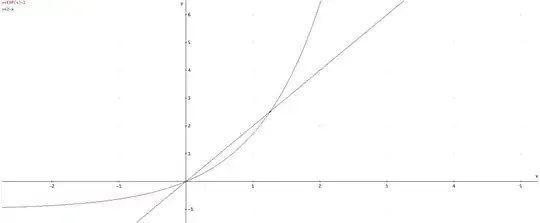By hand
Plot the points $(0,1)$, $(1,e\approx2.7)$, $(2,e^2\approx 7.3)$ on the exponential and intercept with $2x+1$.
Visually,$$x\approx1.3.$$
Using a four operations calculator
Use a Talyor's development to the second order from $x=1$.
$$e^x-1=ee^{x-1}-1\approx e(1+(x-1)+(x-1)^2/2)-1=2x,$$
$$ex^2-4x+e-2=0,$$
$$x\approx\frac{2+\sqrt{4-e(e-2)}}e=1.262$$
Using a simple scientific calculator
Repeat the sequence of keypress [*][2][+][1][=][Ln] until convergence (30 times or so), starting from an approximation like 1.262.
This performs the fixed-point iteration $x_{n+1}=\ln(2x_n+1)$, which gives the solution.
$$x\approx1.25643121.$$
Analytically
Consider the function $y(x)=e^x-2x-1$, its inverse $x(y)$, and the Taylor development of the latter:
$$\frac{dx}{dy}=\frac1{\frac{dy}{dx}}=\frac1{e^x-2},$$
then by the chain rule,
$$\frac{d^2x}{dy^2}=-\frac{e^x}{(e^x-2)^2}\frac{dx}{dy}=-\frac{e^x}{(e^x-2)^3},$$
$$\frac{d^3x}{dy^3}=\Big(-\frac{e^x}{(e^x-2)^3}+\frac{3e^{2x}}{(e^x-2)^4}\Big)\frac{dx}{dy}=-\frac{e^x}{(e^x-2)^4}+\frac{3e^{2x}}{(e^x-2)^5},$$
$$...$$
You can develop around a close approximation of the root, $x_0=\frac54, y_0=e^{x_0}-2x_0-1$, giving
$$x(y)=x_0+\frac1{e^{x_0}-2}(y-y_0)-\frac{e^{x_0}}{(e^{x_0}-2)^3}\frac12(y-y_0)^2+\\\Big(-\frac{e^{x_0}}{(e^{x_0}-2)^4}+\frac{3e^{2{x_0}}}{(e^{x_0}-2)^5}\Big)\frac16(y-y_0)^3+...$$
Then evaluate
$$x(0)=x_0-\frac1{e^{x_0}-2}y_0-\frac{e^{x_0}}{(e^{x_0}-2)^3}\frac12y_0^2-\\\Big(-\frac{e^{x_0}}{(e^{x_0}-2)^4}+\frac{3e^{2{x_0}}}{(e^{x_0}-2)^5}\Big)\frac16y_0^3+...\\\approx1.25 + 0.00647974514175 - 4.91663237447\cdot10^{-5} - 6.39922963124\cdot10^{-7}-1.02964389462\cdot10^{-8}=1.2564299286$$
